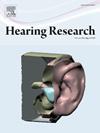用深度学习数字化听力图:结构化数据提取和假名化听觉大数据
IF 2.5
2区 医学
Q1 AUDIOLOGY & SPEECH-LANGUAGE PATHOLOGY
引用次数: 0
摘要
目的性听力损失依赖于纯音测听(PTA);然而,听力图通常作为非结构化图像存储,限制了它们与电子医疗记录(emr)和公共数据模型(cdm)的集成。本研究开发了基于深度学习的听力图数字化系统,为大规模听力大数据采集提供数据的结构化和数字化转换。方法训练卷积神经网络(CNN)从听力图中提取数值频率和阈值。该系统由预处理、模式分类、图像分析和后处理四个模块组成。使用光学字符识别(OCR)提取患者数据,然后假名化,以防止个人和敏感信息泄露。该模型使用8847个听觉符号进行训练,使用2443个听觉符号进行测试。结果该模型对右耳和左耳的诊断准确率分别达到95.01%和98.18%。它处理听力图的速度比人工数字化快17.72倍,将处理时间从63.27秒减少到3.57秒。结构化数据格式允许无缝集成到大数据和cdm中,确保符合假名化和匿名化协议。该模型提高了临床和研究应用的数据可访问性和可扩展性。与以前主要关注分类或预测的研究不同,该框架在遵守数据假名规则的同时确保了结构化的数字数据输出。结论基于深度学习的系统提高了听图数字化的效率和准确性,有利于听力大数据的构建、与cdm的集成、人工智能驱动诊断和大规模听力数据分析。本文章由计算机程序翻译,如有差异,请以英文原文为准。
Digitizing audiograms with deep learning: structured data extraction and pseudonymization for hearing big data
Purpose
hearing loss relies on pure-tone audiometry (PTA); however, audiograms are often stored as unstructured images, limiting their integration into electronic medical records (EMRs) and common data models (CDMs). This study developed a deep learning-based system to digitize audiograms, enabling the structured and numerical conversion of data for large-scale hearing big data collection.
Methods
A convolutional neural network (CNN) was trained to extract numerical frequency and threshold values from audiograms. The system consists of four modules: preprocessing, pattern classification, image analysis, and post-processing. Optical character recognition (OCR) was employed to extract patient data, which were then pseudonymized to prevent leakage of personal and sensitive information. The model was trained using 8847 audiometric symbols and tested using 2443 symbols.
Results
The model achieved accuracy of 95.01 % and 98.18 % for the right and left ears, respectively. It processed audiograms 17.72 times faster than manual digitization, reducing processing time from 63.27 s to 3.57 s per audiogram. The structured data format allows seamless integration into big data and CDMs, ensuring compliance with pseudonymization and anonymization protocols.
Discussion
The model improves data accessibility and scalability for both clinical and research applications. Unlike previous studies that primarily focused on classification or prediction, this framework ensures a structured numerical data output while adhering to data pseudonymization regulations.
Conclusion
This deep learning-based system enhanced the efficiency and accuracy of audiogram digitization, facilitating the construction of hearing big data, integration with CDMs, AI-driven diagnostics, and large-scale hearing data analysis.
求助全文
通过发布文献求助,成功后即可免费获取论文全文。
去求助
来源期刊

Hearing Research
医学-耳鼻喉科学
CiteScore
5.30
自引率
14.30%
发文量
163
审稿时长
75 days
期刊介绍:
The aim of the journal is to provide a forum for papers concerned with basic peripheral and central auditory mechanisms. Emphasis is on experimental and clinical studies, but theoretical and methodological papers will also be considered. The journal publishes original research papers, review and mini- review articles, rapid communications, method/protocol and perspective articles.
Papers submitted should deal with auditory anatomy, physiology, psychophysics, imaging, modeling and behavioural studies in animals and humans, as well as hearing aids and cochlear implants. Papers dealing with the vestibular system are also considered for publication. Papers on comparative aspects of hearing and on effects of drugs and environmental contaminants on hearing function will also be considered. Clinical papers will be accepted when they contribute to the understanding of normal and pathological hearing functions.
 求助内容:
求助内容: 应助结果提醒方式:
应助结果提醒方式:


